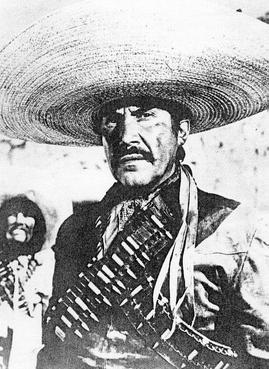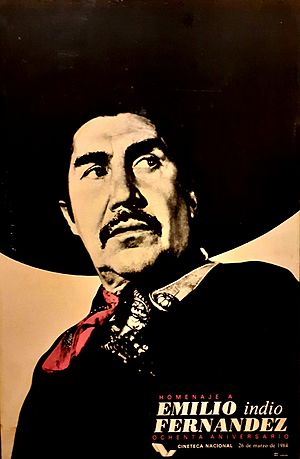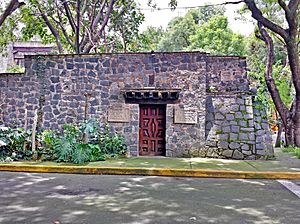Emilio Fernández facts for kids
Quick facts for kids
Emilio Fernández
|
|
|---|---|

Emilio Fernández in the film The Soldiers of Pancho Villa (1959)
|
|
| Born |
Emilio Fernández Romo
26 March 1904 |
| Died | 6 August 1986 (aged 82) Mexico City, Mexico
|
| Years active | 1928–1986 |
| Spouse(s) | Gladys Fernández Columba Domínguez |
Emilio "El Indio" Fernández Romo (born March 26, 1904 – died August 6, 1986) was a famous Mexican film director, actor, and screenwriter. He was one of the most active and important film directors during the Golden Age of Mexican cinema in the 1940s and 1950s. He is especially known for directing the movie María Candelaria (1944), which won a big award called the Palme d'Or at the 1946 Cannes Film Festival. As an actor, he appeared in many movies in Mexico and in Hollywood.
Contents
Early Life and First Steps in Film
Emilio Fernández Romo was born in Sabinas, Coahuila, Mexico, on March 26, 1904. His father was a general in the Mexican Revolution, and his mother was from the Kickapoo Native American group. Emilio loved his country and its traditions very much. He was known for being strong-willed and proud of his Native American background.
When he was a teenager, something difficult happened that made him leave home and join the Mexican Revolution. Later, he went to the Mexican Military Academy. In 1923, he was part of a rebellion that didn't succeed, and he was sent to prison. He managed to escape and left Mexico. He lived in Chicago and then in Los Angeles, where he worked many different jobs like laundry, bartending, and helping with construction for Hollywood studios. This is how he started working in movies, first as an extra and a stunt double for stars like Douglas Fairbanks.
Was He the Oscar Model?
There's a story that Emilio Fernández was the model for the famous Oscar statuette. The legend says that Cedric Gibbons, an art director for MGM, met Fernández through actress Dolores del Río. Gibbons then supposedly convinced Fernández to pose for the statue. However, this story has never been fully confirmed.
Even though he started in movies by chance, it became very important to him. A friend, Adolfo de la Huerta, encouraged him, saying: "Mexico doesn't need more revolutions, Emilio. You are in the center of film, and film is the best way we have to express ourselves. Learn to make movies and come back to our country with that knowledge. Make our films so you can share your ideas with thousands of people."
In 1930, he had an experience that changed his view on filmmaking. He was in the United States when the famous Soviet film director Sergei Eisenstein visited. Emilio watched Eisenstein's films and was very impressed by their unique style, which was different from Hollywood movies. A few years later, seeing parts of Eisenstein's film Que viva Mexico! made him even more determined to make his own movies.
He returned to Mexico in 1933 and decided to continue his film career. He worked as a boxer, a diver in Acapulco, and a baker for a while. In 1934, he started acting in films. He played a robber in Cruz Diablo and a native character in Janitzio. This is when his acting career really began.
The Golden Age of Mexican Cinema
Emilio "El Indio" Fernández stayed busy in Mexico, working on many films. In 1941, with some financial help, he directed his first movie, La isla de la pasión. That same year, he met Gladys Fernández in Cuba, who became his first wife. He also adopted her daughter, Adela.
In 1943, he joined a team at Films Mundiales, a Mexican film studio. This team included Emilio Fernández as director, Mauricio Magdaleno as writer, Gabriel Figueroa as photographer, and actors Dolores del Río and Pedro Armendáriz. They became a very successful group, making some of the biggest movies of that time. Their first film together was Flor silvestre, which was Dolores del Río's first movie in Mexican cinema.
After that, Fernández directed the very popular María Candelaria (1944). For this film, he and Gabriel Figueroa won the Palm d'Or at the Cannes Film Festival. Emilio Fernández created his own special style that showed rural Mexico in a way that became famous around the world.
In 1945, he directed La perla, based on a story by American writer John Steinbeck. Many critics consider La perla one of his most important films. It tells a story about human struggles and greed, brought to life by Figueroa's photography and Fernández's directing. This film won several awards, including for Best Cinematography at the Venice Film Festival (1947) and the Silver Ariel (1948) for Best Picture.
At this time, his career was at its peak. He went on to direct other famous films like Enamorada with María Félix, Río Escondido, and Pueblerina with his wife at the time, Columba Domínguez. In 1949, his film Salon Mexico won an award for Best Cinematography. He also made his only Hollywood film, The Torch, in 1950.

By the mid-1950s, Emilio Fernández's films became less popular, and other directors like Luis Buñuel became more prominent. Fernández then focused more on acting. In the 1960s, he appeared in many films, including The Soldiers of Pancho Villa (1959), The Night of the Iguana (1964), and The Appaloosa (1966) with Marlon Brando. He also acted in three films directed by Sam Peckinpah: The Wild Bunch (1969), Pat Garrett and Billy the Kid (1973), and Bring Me the Head of Alfredo Garcia (1974).
Later Years and Passing
In his last years, Emilio Fernández mostly acted and did not direct films. In early 1986, he fell at his home and broke his leg. Sadly, he passed away on August 6, 1986.
Legacy and Impact
Emilio Fernández left a huge mark on Mexican cinema. He directed 129 films and helped share Mexican culture with the world through his movies. He showed images of Mexican people and society that were loved globally.
His work has been honored with awards like the Ariel Award and a special recognition at the Moscow Film School. Emilio Fernández Romo was known for creating strong characters, dramatic stories, and for showing the real Mexican culture in his films. He worked closely with photographer Gabriel Figueroa, writer Mauricio Magdaleno, and actors like Pedro Armendáriz and Dolores del Río to promote Mexican traditions and the values of the Mexican Revolution.
He was even played by actor Joaquín Cosio in the Mexican movie Cantinflas.
Emilio Fernández was Latin America's most famous filmmaker in the late 1940s. He remained Mexico's top director until the mid-1950s. The "Golden Age" of Mexican movies eventually ended as many famous directors and actors grew older or passed away.
Fernández directed 43 films between 1942 and 1979. He also helped write 40 films. He even worked on American films made in Mexico, like The Magnificent Seven (1960), to make sure that Mexican characters were shown respectfully.
His film La Perla was added to the National Film Registry of the United States Library of Congress in 2002, which means it's considered very important.
In November 2004, on what would have been his 100th birthday, Emilio Fernández and Gabriel Figueroa were honored at the Puerto Vallarta Film Festival in Mexico.
Personal Life
Emilio Fernández married Gladys Fernández in 1941. They had a daughter named Adela Fernández y Fernández, who became a writer. Their relationship ended because of Emilio's strong feelings for actress Dolores del Río.
His longest relationship was with actress Columba Domínguez. They were together for seven years. They had a daughter named Jacaranda, who sadly passed away in 1978.
He also had another daughter, Xochitl Fernández De Valois, with Gloria De Valois Cabiedes.
Emilio Fernández was very fond of the British-American actress Olivia de Havilland, even though he never met her. He even asked the president of Mexico at the time, Miguel Alemán, to extend a street near his house in Coyoacán and name it "Dulce Olivia" (Sweet Olivia). This way, he felt she would always be symbolically close to him.
After Emilio Fernández passed away, there was a legal disagreement about his house between his daughter Adela and Columba Domínguez. Adela had been named the sole heir and took possession of his unique fortress-like house in Coyoacán, Mexico City. Columba also claimed the house. Adela passed away in 2013, which made the legal situation unclear.
The House-Fortress of Fernández, which Adela managed until her death, became a place for many cultural activities in Mexico City. It has also been used as a filming location for over a hundred Mexican and foreign movies.
Filmography
As director
| Year | Original title | English title | Production country | Language | Cast | Award nominations (Wins in bold) |
|---|---|---|---|---|---|---|
| 1941 | La isla de la pasión | The Island of the Passion | México | Spanish | Pedro Armendáriz, Isabela Corona | |
| 1942 | Soy puro mexicano | I'm a Real Mexican | Mexico | Spanish | Pedro Armendáriz, Andres Soler | |
| 1942 | Flor Silvestre | Wild Flower | México | Spanish | Dolores del Río, Pedro Armendáriz | |
| 1943 | María Candelaria (aka Xochimilco) | Portrait of Maria | Mexico | Spanish | Dolores del Río, Pedro Armendáriz | Cannes Film Festival – Palm d'Or |
| 1944 | Las Abandonadas | The Abandoned | Mexico | Spanish | Dolores del Río, Pedro Armendáriz | Ariel Award – Best Actress |
| 1944 | Bugambilia | Bugambilia | Mexico | Spanish | Dolores del Río, Pedro Armendáriz | |
| 1945 | La perla | The Pearl | Mexico | Spanish | Pedro Armendáriz, María Elena Marqués | Venice Film Festival – Golden Lion Ariel Awards – Golden Ariel, Best Actor, Best Supporting Actor, Cinematography Golden Globe – Best Cinematography |
| 1945 | Pepita Jiménez | Mexico | Spanish | Ricardo Montalbán, Rosita Dáz Gimeno | ||
| 1946 | Enamorada | In Love | Mexico | Spanish | María Félix, Pedro Armendáriz | Ariel Award – Best Actress |
| 1947 | The Fugitive (producer) | The Fugitive | United States | English | Henry Fonda, Dolores del Río | |
| 1947 | Río Escondido | Hidden River | Mexico | Spanish | María Félix, Carlos López Moctezuma | Karlovy Vary International Film Festival – Best Photography |
| 1948 | Maclovia | Maclovia | Mexico | Spanish | María Félix, Pedro Armendáriz | |
| 1948 | Pueblerina | Small Town Girl | Mexico | Spanish | Columba Dominguez, Roberto Cañedo | Cannes Film Festival – Official Selection Karlovy Vary International Film Festival – Best Photography |
| 1949 | La Malquerida | A Woman without Love | Mexico | Spanish | Dolores del Río, Pedro Armendáriz | |
| 1950 | Salón México | Mexico Lounge | Mexico | Spanish | Marga López, Miguel Inclan | Brussels Film Festival – Best Photography |
| 1950 | Duelo en las montañas | Duel in the Mountains | Mexico | Spanish | Rita Macedo, Roberto Cañedo | |
| 1950 | The Torch | United States | English | Paulette Goddard, Pedro Armendáriz | ||
| 1950 | Un día de vida | One Day of Life | Mexico | Spanish | Columba Domínguez, Roberto Cañedo | |
| 1951 | Vìctimas del Pecado | Victims of the Sin | Mexico | Spanish | Ninón Sevilla, Rodolfo Acosta | |
| 1951 | Maria Islands | Mexico | Spanish | Pedro Infante, Jaime Fernández | ||
| 1951 | La bienamada | The Beloved | Mexico | Spanish | Columba Domínguez, Roberto Cañedo | |
| 1952 | Siempre tuya | Always Yours | Mexico | Spanish | Jorge Negrete, Gloria Marín | |
| 1952 | Acapulco | Mexico | Spanish | Elsa Aguirre, Miguel Torruco | ||
| 1952 | Cuando levanta la niebla | When the Fog Lifts | Mexico | Spanish | Columba Domínguez, Arturo de Córdova | |
| 1953 | La Red (aka Rossana) | The Red | Mexico | Spanish | Rossana Podestà, Armando Silvestre | Cannes Film Festival- Best Narration |
| 1953 | Reportaje | Report News | Mexico | Spanish | ||
| 1953 | El Rapto | The Rapture | Mexico | Spanish | María Félix, Jorge Negrete | |
| 1955 | La rosa blanca | The White Rose | Cuba | Spanish | Jorge Mistral, Rebeca Iturbide | |
| 1955 | La Tierra del Fuego se apaga | Tierra del Fuego is off | Argentina | Spanish | Jorge Mistral, Bertha Moss | |
| 1958 | Una cita de amor | An appointment with love | Mexico | Spanish | Silvia Pinal, Jaime Fernández | 8th Berlin International Film Festival – Official Selection |
| 1962 | Pueblito | Little Town | Mexico | Spanish | Columba Domínguez, Lilia Prado | San Sebastián International Film Festival – Las perlas del Cantábrico |
| 1963 | Paloma herída | Wounded Dove | Mexico/Guatemala | Spanish | Patricia Conde, Columba Domínguez | |
| 1967 | Un Dorado de Pancho Villa | A Faithful Soldier of Pancho Villa | Mexico | Spanish | Emilio Fernández, Maricruz Olivier | 5th Moscow International Film Festival – Official Selection |
| 1969 | Un Crepúsculo de un dios | A Twilight of a God | Mexico | Spanish | Emilio Fernández, Guillermo Murray | |
| 1974 | La Choca | la Choca | Mexico | Spanish | Pilar Pellicer, Gregorio Casals | Ariel Award – Best Direction, Best Supporting Actress, Best Photography, Best Edition Karlovy Vary Film Festival – Best Direction |
| 1976 | Zona Roja | Red Zone | Mexico | Spanish | Fanny Cano, Armando Silvestre | |
| 1979 | México Norte | Mexico North | Mexico | Spanish | Patricia Reyes Spíndola, Roberto Cañedo |
As actor
- 1928: El destino
- 1930: Oklahoma Cyclone – Pancho Gomez (uncredited)
- 1930: The Land of Missing Men – Lopez – aka Black Coyote
- 1930: Headin' North – Mexican Gambler (uncredited)
- 1931: Sunrise Trail – Pancho (uncredited)
- 1932: The Western Code – Indian Joe
- 1933: Laughing at Life – Revolutionary (uncredited)
- 1933: Flying Down to Rio – Dancer (uncredited)
- 1934: La buenaventura – Boris
- 1934: Corazón bandolero – Chacal
- 1934: Cruz Diablo – Toparca, bandolero
- 1935: Martín Garatuza
- 1935: Tribu – Itzul
- 1935: Janitzio – Zirahuén
- 1936: Celos – Sebastián
- 1936: María Elena – Bailarín de La Bamba
- 1936: Allá en el Rancho Grande – Dancer
- 1937: El superloco – Idúa
- 1937: El impostor
- 1937: Las cuatro milpas
- 1937: Las mujeres mandan – Bailarín
- 1937: Almas rebeldes
- 1937: Adiós Nicanor – Nicanor
- 1939: Juan sin miedo – Valentin
- 1939: With Villa's Veterans – Mayor El Indio Fernández
- 1940: El fanfarrón: ¡Aquí llegó el valentón! – Aguilucho (Juan José)
- 1940: Los de Abajo – Pancracio
- 1940: El charro Negro – Emilio Gómez
- 1941: El Zorro de Jalisco – Ernesto
- 1941: Rancho Alegre
- 1942: La isla de la pasión
- 1943: Wild Flower – Rogelio Torres
- 1959: The Soldiers of Pancho Villa – Coronel Antonio Zeta
- 1962: Pueblito – Coronel (uncredited)
- 1963: La bandida – Epigmenio Gómez
- 1963: Paloma herida – Danilo Zata
- 1964: El revólver sangriento – Félix Gómez
- 1964: The Night of the Iguana – Barkeeper (uncredited)
- 1964: Yo, el valiente
- 1964: Los hermanos Muerte – Marcos Zermeño
- 1965: The Reward – Sgt. Lopez
- 1965: La conquista de El Dorado
- 1965: Un callejón sin salida – Moran
- 1966: La recta final – Don Lucio
- 1966: Duelo de pistoleros – Pancho Romero
- 1966: The Appaloosa – Lazaro
- 1966: Los malvados – El coyote
- 1966: Return of the Seven – Francisco Lorca
- 1967: A Covenant with Death – Igancio
- 1967: Un tipo dificil de matar
- 1967: The War Wagon – Calita
- 1967: A Faithful Soldier of Pancho Villa – Aurelio Pérez
- 1967: El silencioso – Emilio Segura
- 1968: Guns for San Sebastian
- 1968: El caudillo – Coronel
- 1968: Un toro me llama
- 1969: The Wild Bunch – General Mapache
- 1969: Duelo en El Dorado – Indio Romo
- 1969: El crepúsculo de un Dios – Himself
- 1970: The Phantom Gunslinger – Sheriff
- 1971: La chamuscada (Tierra y libertad) – Coronel Margarito Herrero
- 1971: La sangre enemiga – Juan
- 1972: Indio – Victorio
- 1972: El rincón de las vírgenes – Anacleto Morones
- 1973: Pat Garrett and Billy the Kid – Paco
- 1974: Bring Me the Head of Alfredo Garcia – El Jefe
- 1974: Breakout – J.V.
- 1975: Lucky Lady – Ybarra
- 1975: Detras de esa puerta – Police Director
- 1976: Zona roja
- 1979: Erótica – Hernández
- 1980: Las cabareteras
- 1982: Una gallina muy ponedora
- 1983: Mercenarios de la Muerte – Maestro tata
- 1984: Under the Volcano – Diosdado
- 1985: Treasure of the Amazon – Tacho / Paco
- 1985: Lola la trailera – Leoncio's Bodyguard
- 1986: Los Amantes del Señor de la Noche – Don Venustiano
- 1986: The Kidnapping of Lola – Commander Prieto
- 1986: Ahora mis pistolas hablan
- 1987: Arriba Michoacán (final film role)
See also
 In Spanish: Emilio Fernández para niños
In Spanish: Emilio Fernández para niños



